Ocean Storytelling Photography Grant Finalists
We are excited to announce the 11 finalists of the SOSF Ocean Storytelling Photography Grant 2021!
The judges reviewed 152 applications from a diverse range of talented photographic storytellers from across the globe. Given the exceptional quality of submissions and after much deliberation, the judges reached a unanimous decision that 11 candidates should be selected as finalists instead of the intended 10. Each finalist will receive a one-hour portfolio review with either Kathy Moran, Thomas Peschak or Jennifer Samuel as well as a copy of Thomas Peschak’s book Sharks and People.
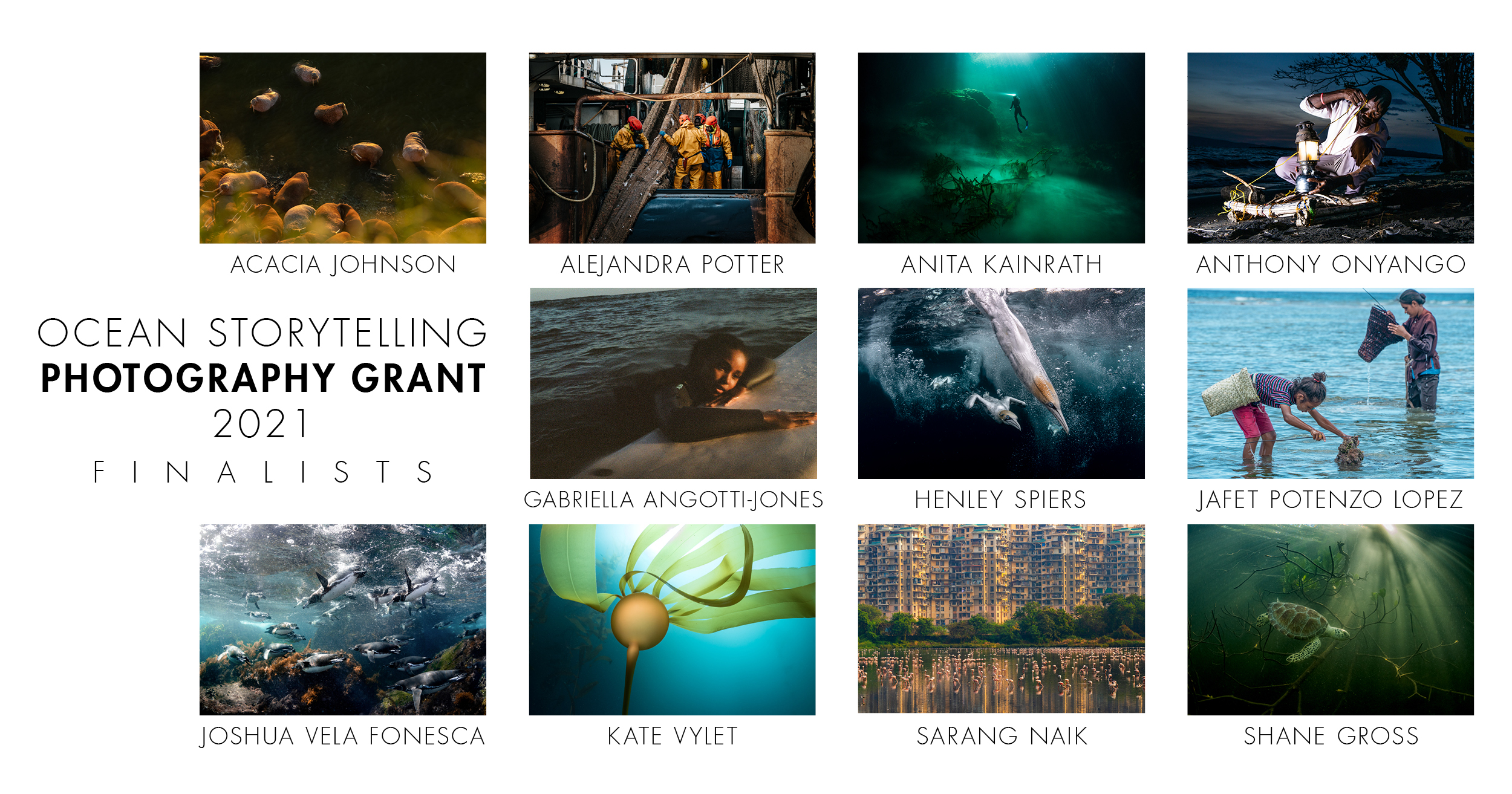
Save Our Seas Foundation Ocean Storytelling Photography Grant 2021 finalists. Artwork by Nicola Poulos for Save Our Seas Foundation.
The four winners will be selected from these 11 finalists and will be announced on 1 February 2022.
- Each winner will receive a US$2,000 cash prize and will be given a paid three-week photographic assignment to document an SOSF-supported marine research or conservation project. The SOSF has funded more than 400 projects in more than 85 countries and the winning photographers will be assigned to tell one of these stories.
- Thomas P. Peschak, National Geographic Magazine photographer and Director of Storytelling for the Save Our Seas Foundation, Kathy Moran, senior editor (natural history) of National Geographic Magazine and Jennifer Samuel, photo editor at National Geographic, will mentor photographers throughout the process.
- All winners will be given the chance to showcase their work at an international conference or an exhibition, with travel expenses included
- Each winner’s story will also be published as a photo essay for Save Our Seas Foundation.
The Ocean Storytelling Photography Grant builds on the legacy of our previous Marine Conservation Photography Grant and is dedicated to finding and supporting a new and diverse generation of conservation storytellers. While we look specifically for photographers who can tell conservation stories about our oceans, the grant is not limited to underwater photography. It is led by our own director of storytelling and National Geographic photographer Thomas Peschak, in collaboration with Kathy Moran and Jennifer Samuel from National Geographic.
Continue reading below to learn more about each of our fantastic finalists!
Acacia Johnson
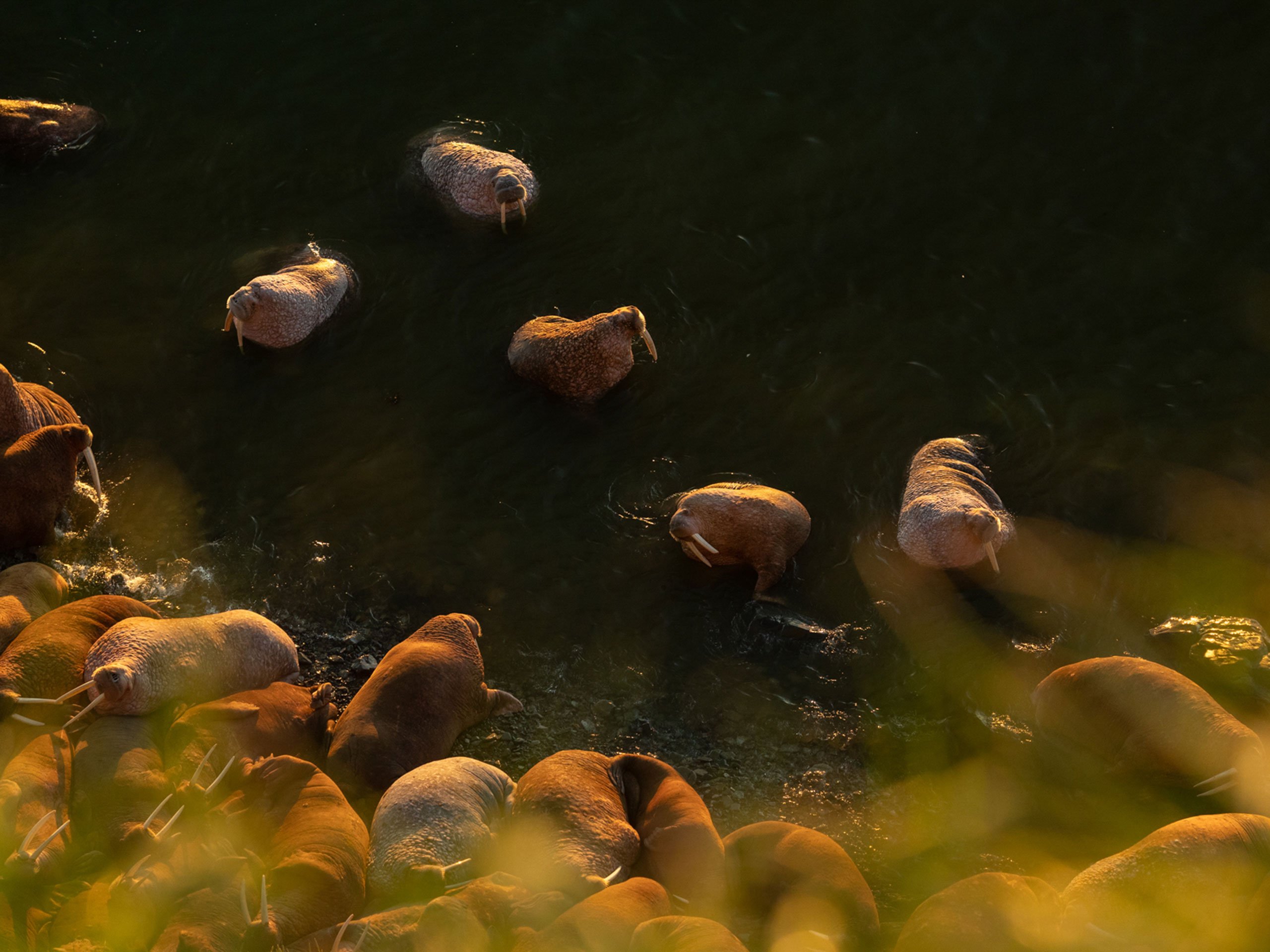
Photo © Acacia Johnson
Acacia Johnson
Finalist
Anchorage, Alaska, United States of America
Photography, to me, is a way of engaging with the beauty of the world. It’s a way of exploring, connecting, asking questions, constantly learning, and looking hard at the world with curiosity and wonder. It’s also a tool to create bridges of awareness between viewers and places, people, and events they might not otherwise connect with or understand.
I grew up spending a lot of time in remote, cold landscapes and, from an early age, was confronted with stereotypes describing the places I loved as ‘desolate’ or ‘harsh’. When I first started photographing, it was out of a desire to challenge those ideas and make the beauty that I saw there visible to other people. Now, I’ve learned to apply this principle to the broader context of photojournalism. What remains out of sight will usually stay out of mind for most people. Many of the most pressing environmental issues occur in ‘remote’ regions to the general public. Photography is a powerful tool for environmental awareness.
When I show my images to people when I take them, they often say, ‘I didn’t see that.’ That inspires me to keep going.
Alejandra Potter
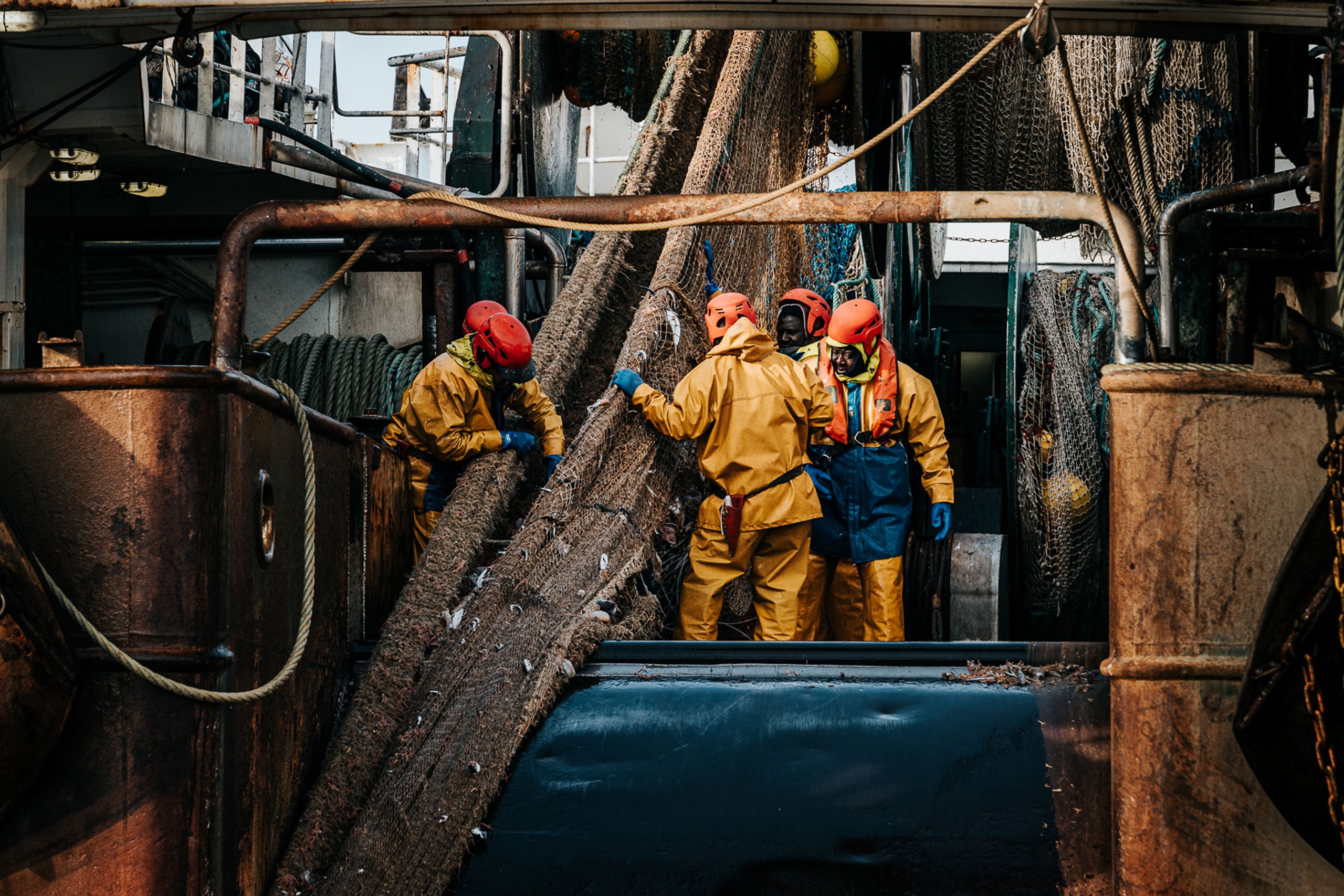
Between salt and rust. Fisherman on board Spanish bottom trawler working off the west coast of France. Photo © Alejandra Potter.
Alejandra Potter
Finalist
Stevenson, Washing State, United States of America
I have always been passionate about wildlife. I grew up watching nature documentaries every day (like a nerd). Eventually, I figured that if I had grown to appreciate nature so much through a screen, so could others. Learning more about the natural world inevitably leads to respecting it, and respect can lead to the desire to protect it. It didn’t take long for me to decide to pick up a camera and find a way to help wildlife by bringing it closer to the public. It is the best tool to transmit my passion to people and hopefully inspire someone.
A camera is especially beneficial for spreading awareness about ocean-related issues. As the saying goes, ‘out of sight, out of mind’, and nothing is more out of sight than what happens out at sea. Lastly, I admit it is also a fantastic excuse for me to be outside in nature and get my nose in the middle of whatever has caught my attention at any given time (which is usually a lot of things).
Anita Kainrath
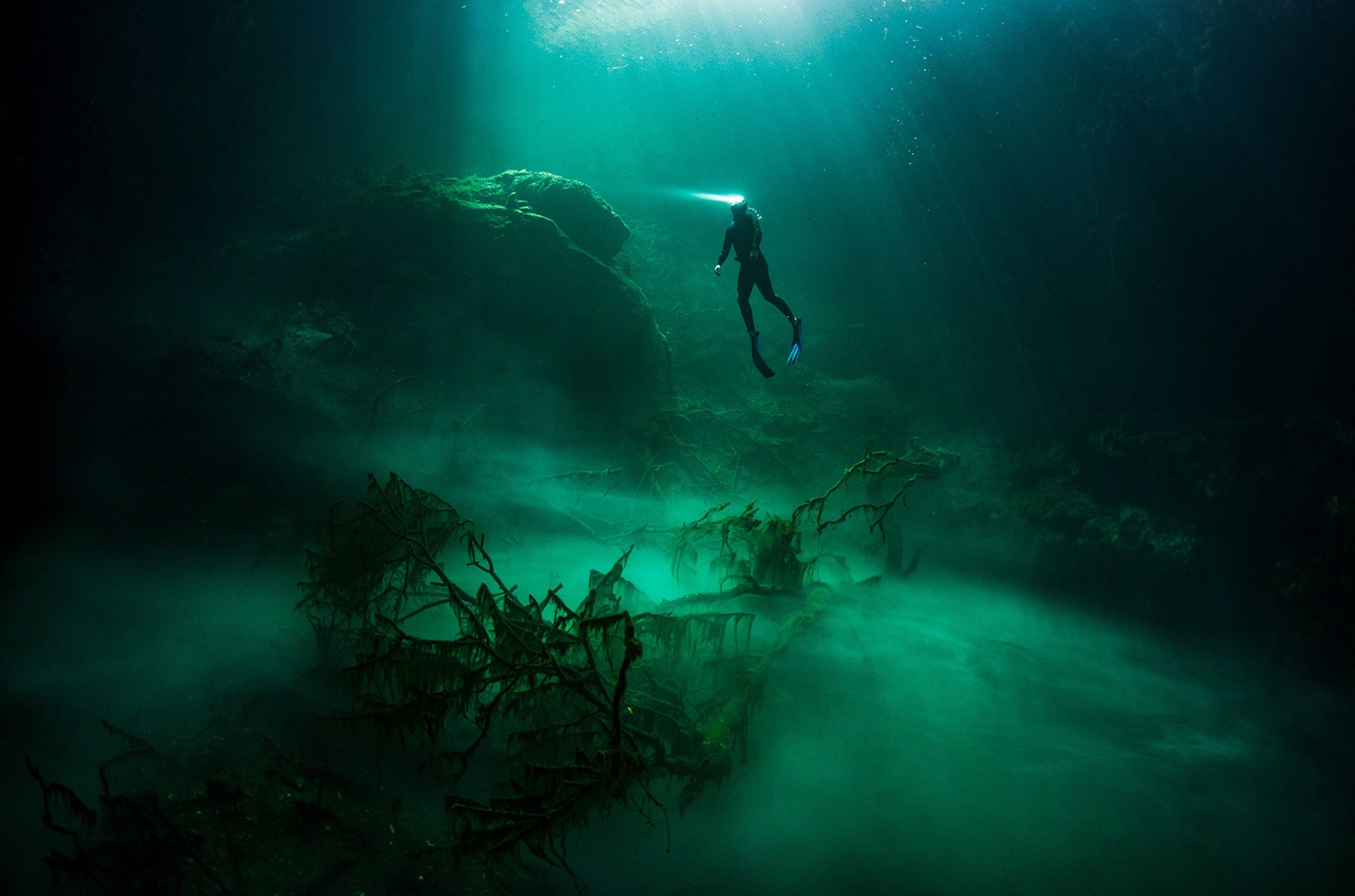
Cuba has so much more to offer than old Cuban cars, rum and good music. Leaving the busy city of Havana, going South you can find untouched nature and a few wild surprises. Photo © Anita Kainrath.
Anita Kainrath
Finalist
Vienna, Austria
I wanted to capture moments for myself and other people. Time flies, especially when you’re underwater and seeing amazing marine life. Experiencing a connection with the ocean and its inhabitants is a life-changing experience for everyone. Seeing people’s smiles, and that they’re being left speechless because of how beautiful the underwater world is when they experience it for the first time, makes me more than happy. It’s one of the most fulfilling experiences to know that there’s one more person out there who will try to take care of our oceans because they feel the same connection to it. What’s more beautiful than capturing that connection?
Anthony Onyango
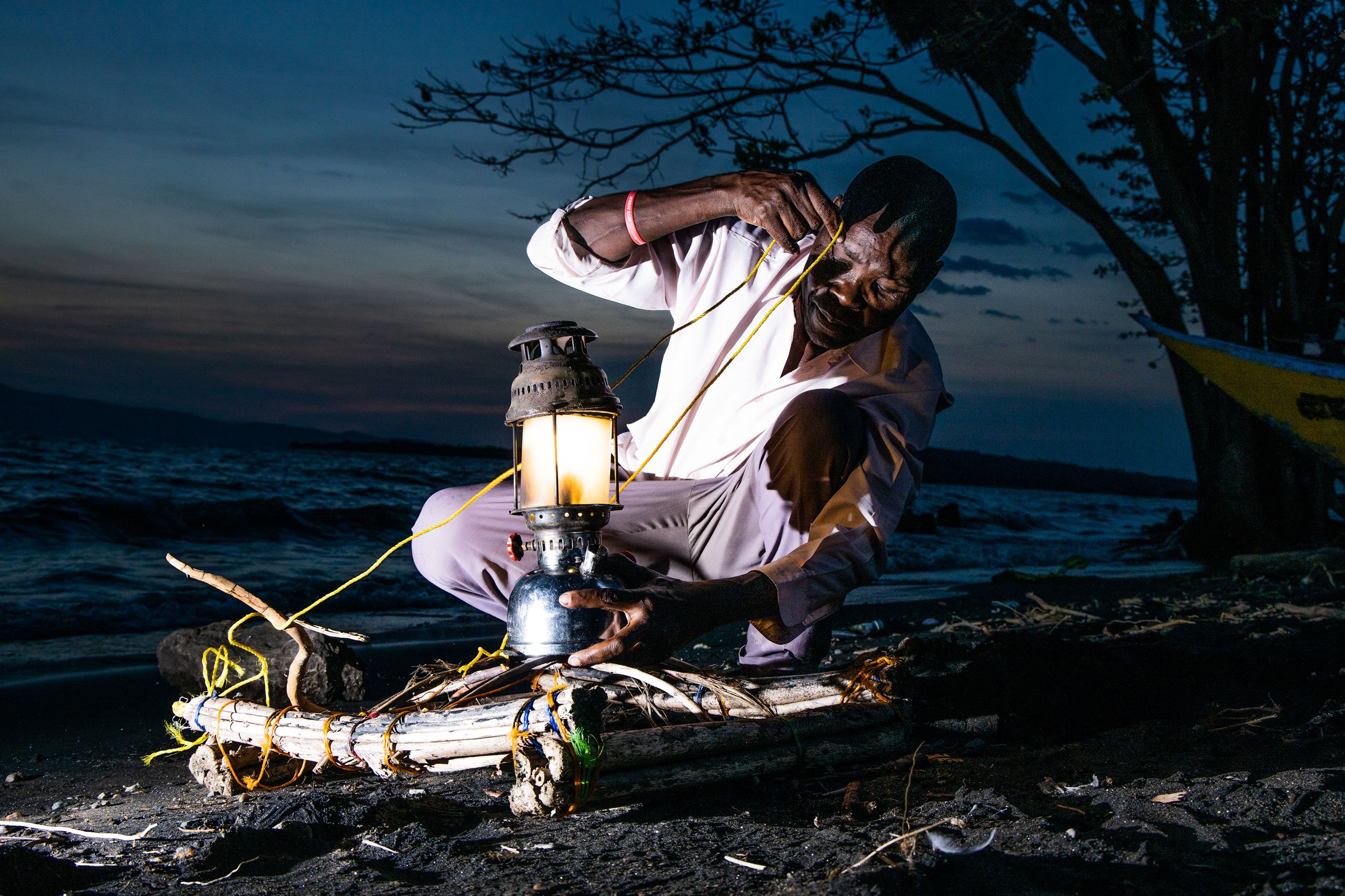
A local fisherman ties a lamp to one of his floating frames before setting out to fish on the enormous Lake Victoria, called 'Nam Lolwe' in our language, Luo. Photo © Anthony Onyango.
Anthony Onyango
Finalist
Nairobi, Kenya
Seeing my people being inspired and taking action that supports wildlife conservation inspires me to tell stories through photography every day. The most grateful feeling is seeing peoples reactions when they see the images I have created and knowing that that might inspire them to do better for our environment. This drives me to do more because I can continue my passion for environmental education through photography and teach my audience, who have had a massive role in conserving wildlife species and habitats.
Imagine a world where every individual makes decisions based on conservation, environmental and sustainable development principles. We will be able to achieve sustainable development goals and have a healthy environment. My dream in life is to make every individual in my circle, and the world, understand why and how they need to conserve the environment and make sustainable decisions while going about their daily lives. Photography plays a crucial role to support my dream.
Gabriella Angotti-Jones

Photo © Gabriella Angotti-Jones.
Gabriella Angotti-Jones
Finalist
Los Angeles, California, United States of America
I grew up in Southern California, living the typical childhood of surfing, outrigging, and eating tacos. I was always in and around the ocean – so much so that I wanted to know all about its mechanics and animals. I studied biology and ecology at MiraCosta College in Oceanside, California, while interning at the Ocean Institute in Dana Point as a husbandry and research intern.
During my internship, I realized that our oceans are warming and changing faster than our atmosphere. I felt the need to bridge the information gap between scientists and everyday people, and I’ve always enjoyed documentary photography. So, I bought a camera and taught myself how to shoot while documenting my internship.
As a woman of colour, I feel the need to help change the narrative of covering communities of colour. We live in a ‘post-racial society’, an era where racism is systematic enough to be effective, but concealed enough to be denied. The lack of our presence constrains people of colours’ varied perspectives to worn-out stereotypes. If minorities (including gender nonconforming and LGTBQIA+ people) are more present in publications, ideas can be monitored by correcting biases before they are formed.
Henley Spiers
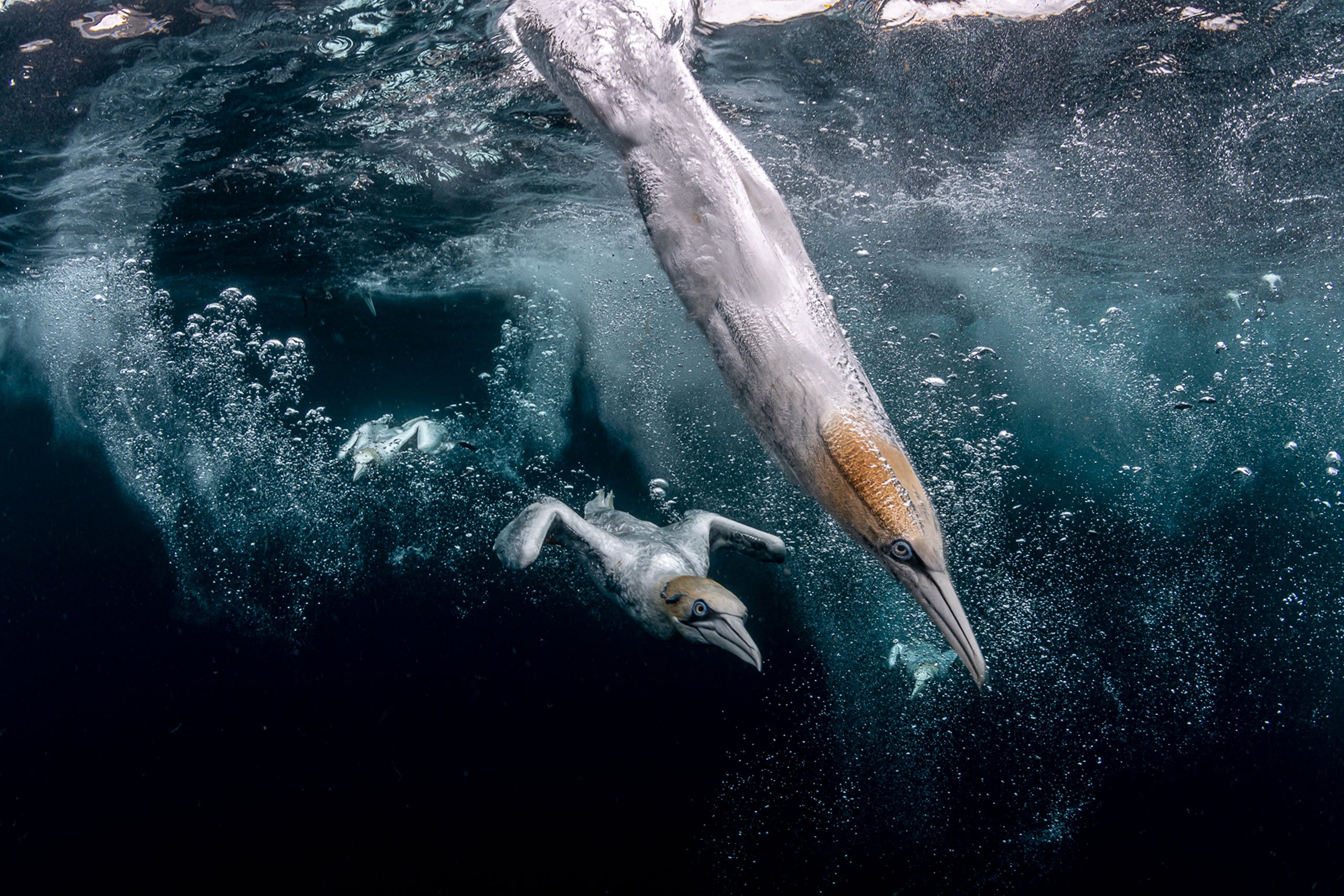
Handsome gannets torpedo into the water faster than an Olympic diver, with airbags to shield from the impact. Photo © Henley Spiers.
Henley Spiers
Finalist
Exeter, United Kingdom
From expansive childhood snorkel sessions to becoming a scuba diver at 12 years old, to abandoning a corporate job to pursue a career as a dive instructor and eventually, as an underwater photographer; the inspiration and peace offered by the ocean are unparalleled. Beneath the surface, despite the unfortunate physiological limitations of the human body, is where I feel a level of contentment that has always proved elusive on land. Underwater is also where I am overcome with awe for the life that exists on our planet, much of it concealed by the delicate veil of water.
Pictures offer the opportunity to share the wonder of the oceans, and it feels like a natural step to try and transmit the power, grace, and fragility of the oceans to those who do not get to experience them as closely. The greatest challenge with photography is to create imagery that matches up to the beauty and emotion that one feels when face-to-face with the scene. A good day is one where the power of the pictures creates matches up to the power of seeing it live.
Jafet Potenzo Lopes
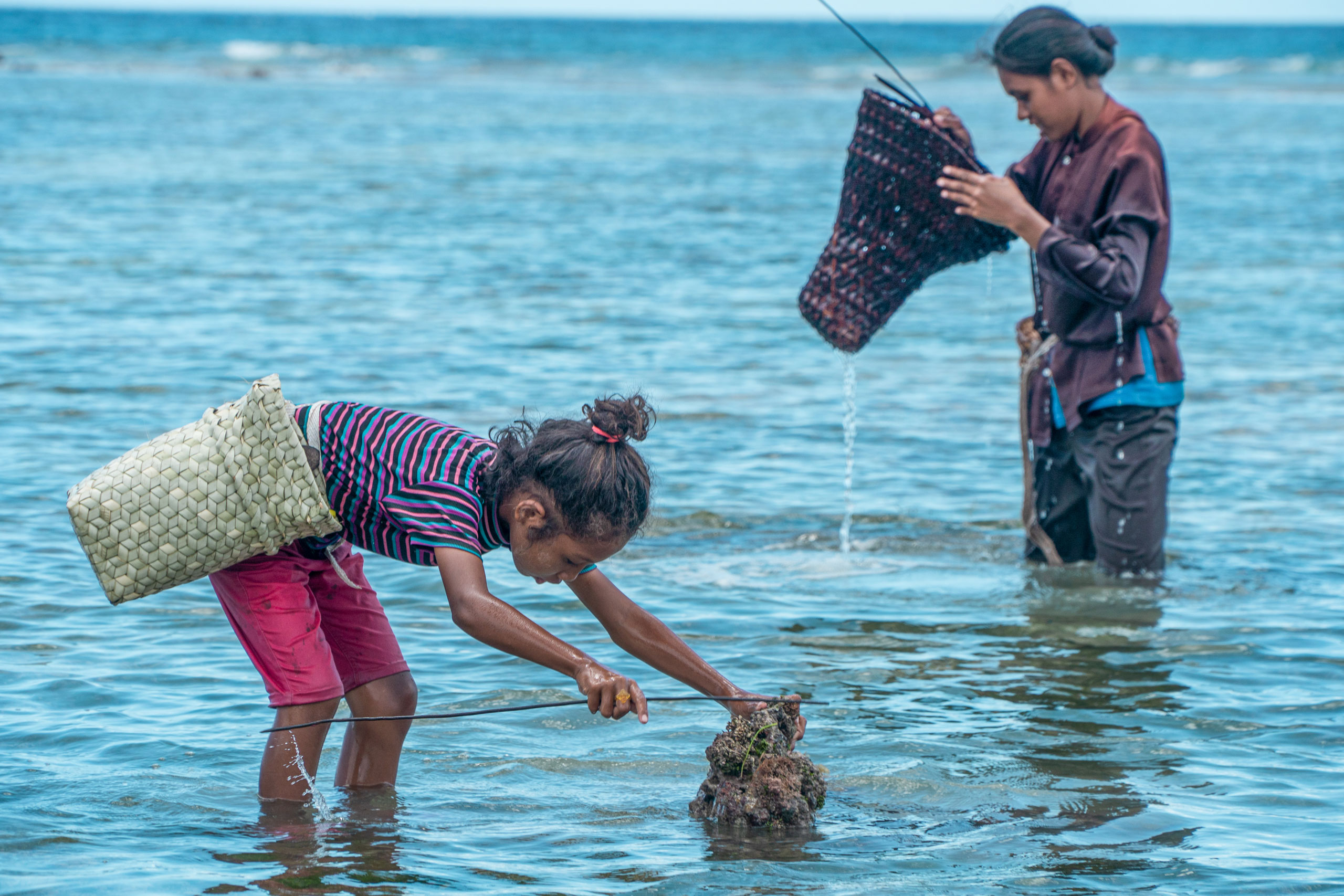
'Young women engage in fishing activities.' Fishing is often thought of as a man's world, but if we ignore women's contribution - young and old, we miss the complete picture of social-ecological links of marine ecosystems. Photo © Jafet Lopes.
Jafet Potenzo Lopes
Finalist
Dili, East Timor
I come from a small fishing town in the Eastern part of Timor-Leste, and many of my family members make a living from fishing. Growing up, I spent a lot of time at the ocean with my father. It was my playground and I have always been fascinated with its beauty and inhabitants.
During the Indonesian occupation, bombs were dropped in the ocean close to my family’s house and seeing how the coral reef was destroyed had a profound effect on me as a child. More recently, being an animal and wildlife lover, witnessing people killing sharks and dugongs in my community deeply troubled me and propelled me to do something and to spread the message to protect marine life. I wish to use my skills and experience to give back to this special place and hopefully be a part of protecting our planet.
I am thankful for mother nature that I grew up in one of the most beautiful places in the world and I am grateful I can stay close to my roots and share the beauty of Timor-Leste with the rest of the world.
Joshua Vela Fonseca
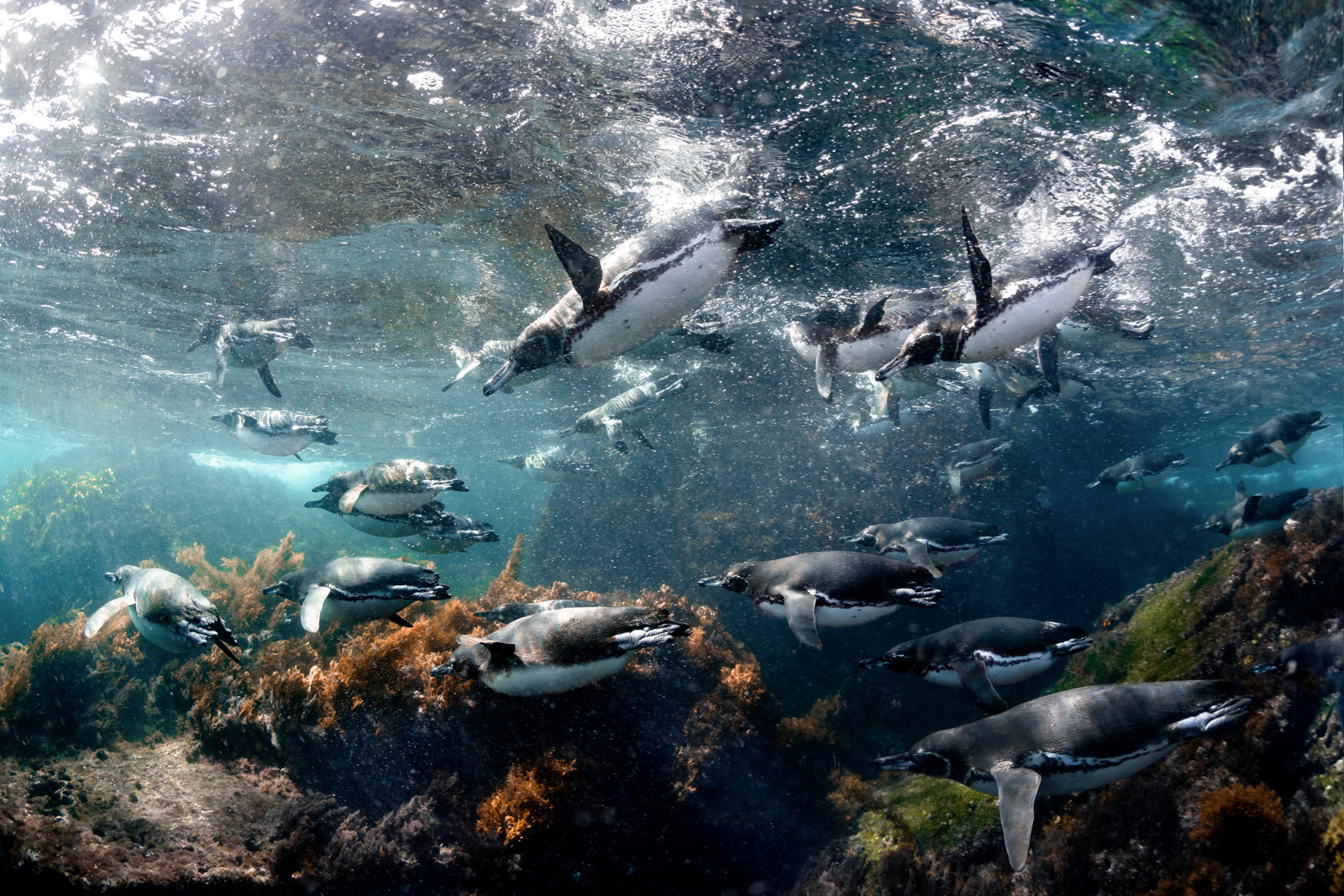
In 2020, the Galápagos National Park Directorate surveyed the penguin population of Galápagos and a record number of 1,940 individuals was reported. In 2021 we were lucky enough to encounter a a thriving population of penguins in various parts of the archipelago. Photo © Joshua Vela Fonseca.
Joshua Vela Fonseca
Finalist
Santa Crus, Galápagos, Ecuador
I feel lucky to have grown up in the ’90s and ’00 in the Galapagos Islands, right in the transition to smartphones and digital cameras. As a child, I was always taking pictures with my Nokia 3220 or my BlackBerry of whatever creature I encountered and when I had to choose my career, biology and photography were all I could think.
Even though I make a lot of videos, I always go back to photography. I am fascinated by the quality of being able to freeze a unique frame, in which, with luck and skill, the elements align to capture a perfect story with an aesthetic value. Moreover, the technical possibilities in photography seem to be endless: drones, housings, shutter speed effects, lenses, post-processing, you name it. These image experiments and the possibilities drive me to tell unique stories.
I believe that a single image invites us to ‘create’ the story and decode its meaning in our head; it is not as digested as a video, and it will be here as long as technology advances and there is a story waiting to be told.
Kate Vylet
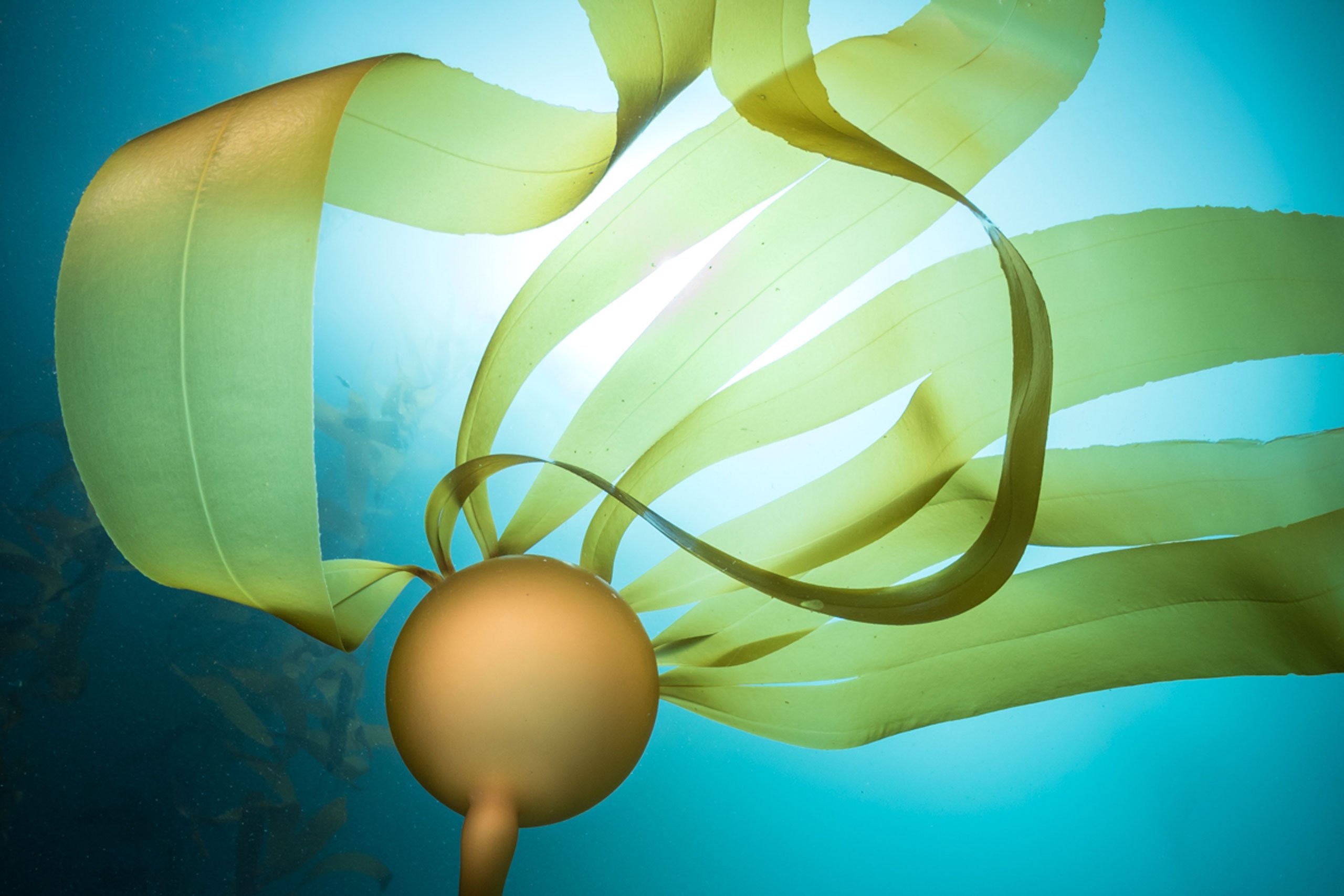
Rising up from the dark depths of the sea, a bull kelp (Nereocystis luetkeana) reaches toward the bright surface. The young alga will grow to break through the thin line between two worlds, basking in sunlight for a fleeting season before the ocean reclaims it; returned to the deep dusk from where it came. Carmel, CA, USA. Photo © Kate Vylet.
Kate Vylet
Finalist
Santa Cruz, California, United States of America
Immersing in the beauty of California’s kelp forests is what inspired me to tell the stories of our wild worlds.
I’ve been photographing nature since I was a child, but it wasn’t until the sea enchanted me that I turned to telling stories with my images. When I took my first bubbly breaths under a kelp canopy in Monterey Bay, I was awestruck – I had no idea of the underwater forest right in my backyard. Diving into the wonder of this hidden world made me realize how much of our wilderness lies out of sight, out of mind. As our actions imperil these underwater ecosystems, how can we care about losing what we don’t know? Submerging in the beauty of the kelp forest inspired me to bring it to the surface through the power of photography, sharing its stories so that everyone can soak in its magic and in turn, care for its conservation.
Sarang Naik

Flamingo City. Flamingos forage in a brackish water lake behind a huge residential complex in Seawoods, Navi Mumbai. Thousands of flamingos migrate to Mumbai between October and May. They find plenty of food in the creeks opening up into the Arabian Sea. When the water in the creeks rises during high tide, they find refuge in the man-made lakes connected to the creeks, such as this one. The residents of these buildings have become protectors of this lake ecosystem. They have been fighting court cases against a private contractor who plans to build another apartment complex and a golf course by reclaiming the lake. Photo © Sarang Naik.
Sarang Naik
Finalist
Mumbai, India
It started purely as a creative outlet for the artist in me. While that is still true, my love for exploring the urban wildlife in my home city of Mumbai drives me. I keep reinforcing the idea that wilderness can be found anywhere through my work. You just have to pay attention.
There is also the urge to dig deeper and understand things from the inside out. To build a fresh perspective on a subject and use photography to share it with people to encourage them to connect with it in a meaningful way.
Shane Gross
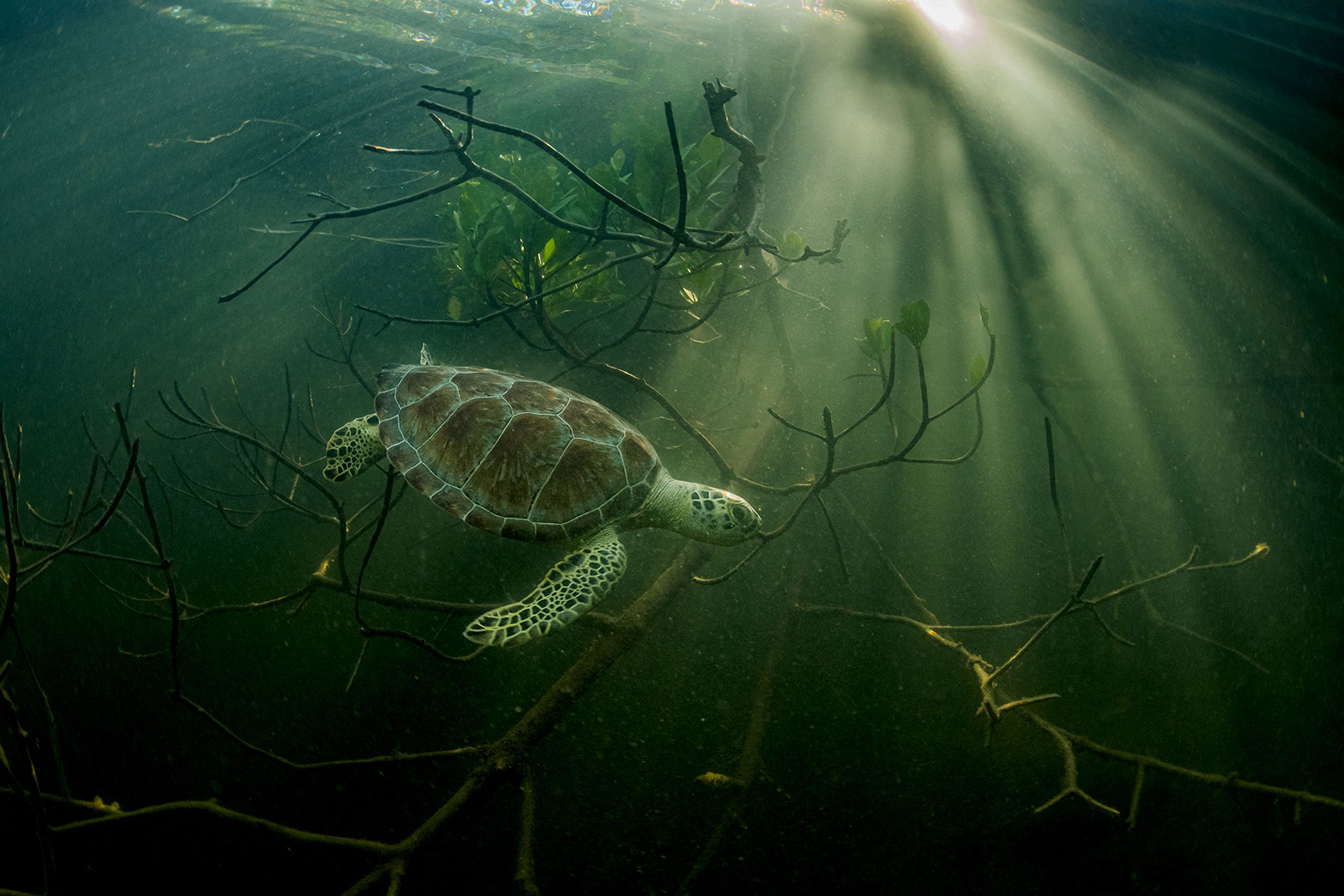
A green sea turtle hides among mangrove trees in The Bahamas. Green turtles are born on beaches, hide among seaweed and floating debris in the open ocean as newborns, move to shallow lagoons as teenagers, feed primarily on seagrass and hide in coral reefs and mangroves. To protect this endangered species, we need to protect large swaths of the ocean, including all those interconnected habitats. Photo © Shane Gross.
Shane Gross
Finalist
Nanaimo, British Columbia, Canada
It all began as a love for sharks. As a kid, I was a huge shark nerd and begged my parents to get me a pet shark we could keep in the bathtub (they wisely didn’t). Every piece of clothing I owned had sharks on them. Jaws was my favourite movie by six years old. Growing up in the Canadian prairies far from any ocean meant I could only experience them through books, magazines and documentaries.
I wished I could be one of those people making the images and wondered how they did it. Then in 2007, SHARKWATER came out, and I realized how badly my beloved sharks were in trouble. And so many others did too. I could see the power of emotional storytelling to change hearts and minds – my own and many around me. I wanted to be Rob Stewart, but I always felt attracted to the still image rather than a moving one. You can stop and study a still image, and you can put your images in places where people who wouldn’t see SHARKWATER can see them.
